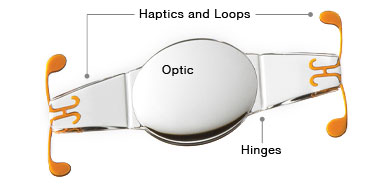A corrective lens implant that compensates for the clouding of the eye’s natural lens due to cataracts caused by aging.
What is a Crystalens® lens implant (IOL) and how does it help improve vision with less need for glasses?
What is an Intraocular Lens Implant? An intraocular lens (IOL) implant is an artificial lens that’s surgically implanted within the eye. This procedure is most commonly performed during cataract surgery, where the natural lens of the eye has become cloudy and needs to be replaced to restore vision. The implant itself is usually made of a clear plastic material, and it is shaped to help focus light onto the retina in much the same way a natural lens does. This is essential for clear vision. There are different types of IOLs available, including monofocal, multifocal, and toric lenses.
More sophisticated technology lenses, such as the Crystalens®, afford a larger scope of concentration without spectacles. This reduces the need for eyewear for patients.
Enhance your sight today!
Call or book your appointment now to unlock your best possible vision…
The Crystalens® is an intraocular lens (IOL) developed to help people to see better, with less dependence on eyeglasses. It mimicks the actions of a healthy eye’s lens by utilizing the same muscles that allow natural lenses to change shape. For Crystalens® cataract surgery, the original lens is extracted and an intraocular lens (IOL) is implanted into the same space occupied by the natural lens. Little muscles in the eye can cause this capsule to alter its form. The Crystalens® is distinctive in that its structure adjusts and fluctuates form when these slight muscles contract and relax. This alters the center of the lens permitting you to view a larger selection of distances without eyewear. It mimics the operation of the human eye’s own lens in dynamically adapting to focus. This is the only accommodating intraocular lens authorized by the U.S. Food and Drug Administration – the only one of its kind. In comparison to traditional intraocular lenses (IOLs), Crystalens® offers additional depth of focus as it does not require shape alterations for accommodating various focal lengths; rather, the lens is composed of rings with varying levels of intensity. The cost of this type of IOL is usually lower than that of a multifocal one.

What are the criteria for being eligible for Crystalens® IOL implantation?
When assessing a person for cataract surgery, numerous tests and scans of the eye are conducted such as mapping of the cornea, ultrasonic gauging of the eye’s form and size, and a macula scan. If there is an excessive amount of astigmatism in the cornea (unevenness in the curvature of the eye’s surface), a Trulign® Toric IOL can be implemented. This lens is analogous to the Crystalens®, but also offers astigmatism resolution.
Why opt for Crystalens® when it offers a narrower field of view compared to a multifocal?
A major benefit of the Crystalens® is its ability to be applied in circumstances where a multifocal IOL (for example, PanOptix®, ReSTOR® or Tecnis®) would not deliver satisfactory results, such as in patients who have experienced sight loss caused by macular degeneration or wrinkles in the macula. The final visual result still depends on the patient’s eye health, but if their condition isn’t serious, they are typically able to attain a variety of clarity with Crystalens®. Since each person differs, we speak in great detail with them concerning the potential vision this lens presents in order to enable them to accurately anticipate their outcomes.
What potential repercussions can result from the installation of the Crystalens® IOL?
The Crystalens® has a distinct form and layout compared to a standard IOL. The lens is implanted in an analogous fashion as a traditional IOL, so the procedure does not have additional peril. The dimension of the lens is a bit petite compared to an ordinary intraocular lens, so there might be a smallish chance of light scattering from the circumference of the IOL in individuals with a great-sized pupil. This generally does not pose a striking difficulty, and many patients conform adequately. It is observed that reading unassisted (without glasses) has poorer results compared to using multifocal IOLs such as PanOptix®, ReSTOR® and Tecnis®, however, it does still provide more variable focus than standard IOLs. Patients who require reading glasses and want to be less reliant on them, but also have a mild macular issue that keeps them from using a multifocal IOL, should consider getting this lens implant.